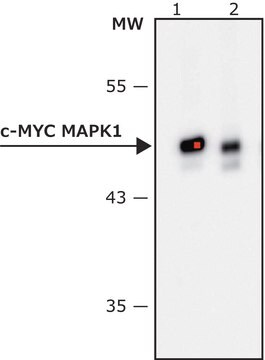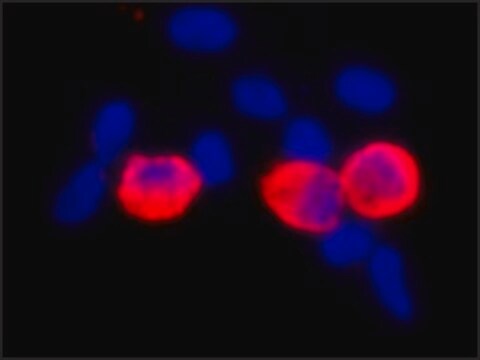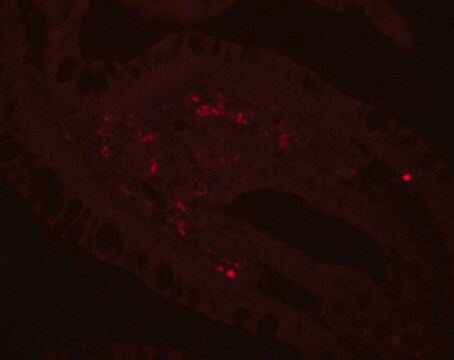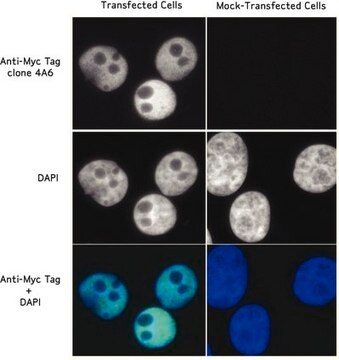추천 제품
일반 설명
The Anti-c-Myc peroxidase conjugate rabbit antibody reacts with c-Myc tagged fusion proteins. It recognizes the c-Myc tag sequence expressed at either the amino- or the carboxyl-terminus.
특이성
N-terminal or C-terminal c-Myc (Glu-Gln-Lys-Leu-Ile-Ser-Glu-Glu-Asp-Leu) tagged fusion proteins.
면역원
peptide corresponding amino acids 408-425 of the human c-myc proto-oncogene, conjugated to maleimide-activated KLH through a C-terminal added cysteine residue.
애플리케이션
Antibody is suitable for immunoblotting.
Applications in which this antibody has been used successfully, and the associated peer-reviewed papers, are given below.
Western Blotting (1 paper)
Western Blotting (1 paper)
물리적 형태
Solution in 0.01 M sodium phosphate buffer saline, pH 7.4, containing 0.05% MIT
제조 메모
Prepared by the two-step glutaraldehyde method described by Avrameas, S., et al., Scand. J. Immunol., 8, Suppl. 7, 7 (1978).
적합한 제품을 찾을 수 없으신가요?
당사의 제품 선택기 도구.을(를) 시도해 보세요.
신호어
Warning
유해 및 위험 성명서
Hazard Classifications
Skin Sens. 1
Storage Class Code
12 - Non Combustible Liquids
WGK
WGK 2
Flash Point (°F)
Not applicable
Flash Point (°C)
Not applicable
이미 열람한 고객
Yang Lu et al.
Molecular biology of the cell, 19(10), 4260-4272 (2008-08-08)
Efg1 is essential for hyphal development and virulence in the human pathogenic fungus Candida albicans. How Efg1 regulates gene expression is unknown. Here, we show that Efg1 interacts with components of the nucleosome acetyltransferase of H4 (NuA4) histone acetyltransferase (HAT)
Rodolfo Zentella et al.
Nature chemical biology, 13(5), 479-485 (2017-03-01)
Plant development requires coordination among complex signaling networks to enhance the plant's adaptation to changing environments. DELLAs, transcription regulators originally identified as repressors of phytohormone gibberellin signaling, play a central role in integrating multiple signaling activities via direct protein interactions
Gang Li et al.
Nature cell biology, 13(5), 616-622 (2011-04-19)
The circadian clock controls many metabolic, developmental and physiological processes in a time-of-day-specific manner in both plants and animals. The photoreceptors involved in the perception of light and entrainment of the circadian clock have been well characterized in plants. However
Zirui Zheng et al.
Journal of immunology (Baltimore, Md. : 1950), 196(3), 1199-1208 (2015-12-25)
IFN regulatory factors play a pivotal role in many cellular processes, including inflammatory and immune responses. Their activation is tightly regulated by TANK-binding kinase 1 (TBK1). In response to microbial components, TBK1 activates IFN regulatory factor 3 (IRF3) and cytokine
Du-Hwa Lee et al.
The Plant cell, 29(11), 2895-2920 (2017-11-01)
Dynamic control of protein translation in response to the environment is essential for the survival of plant cells. Target of rapamycin (TOR) coordinates protein synthesis with cellular energy/nutrient availability through transcriptional modulation and phosphorylation of the translation machinery. However, mechanisms
자사의 과학자팀은 생명 과학, 재료 과학, 화학 합성, 크로마토그래피, 분석 및 기타 많은 영역을 포함한 모든 과학 분야에 경험이 있습니다..
고객지원팀으로 연락바랍니다.










